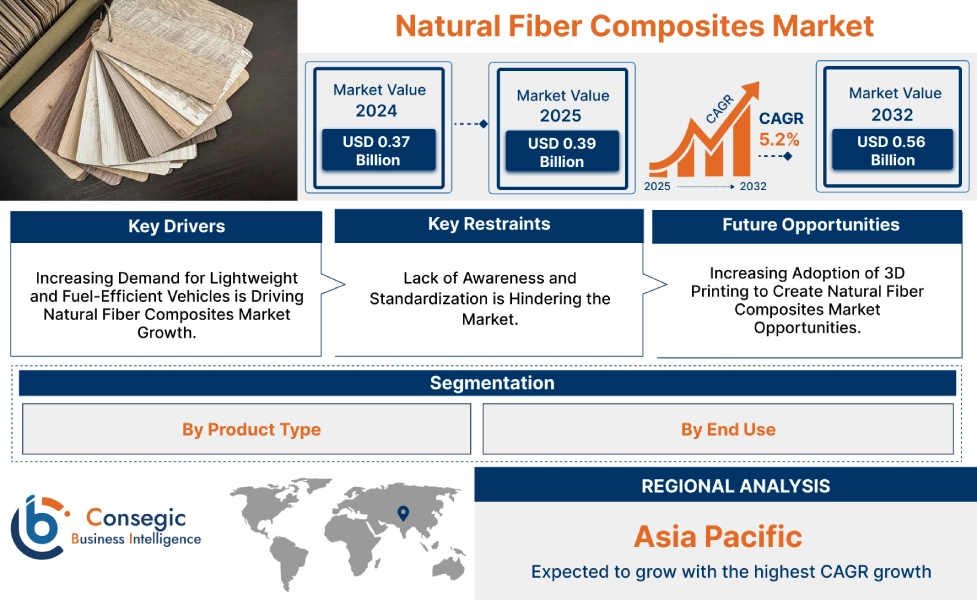Natural Fiber Composites Market Size:
The Natural Fiber Composites Market size is growing with a CAGR of 5.2% during the forecast period (2025-2032), and the market is projected to be valued at USD 0.56 Billion by 2032 from USD 0.37 Billion in 2024. Additionally, the market value for 2025 is attributed to USD 0.39 Billion.
Natural Fiber Composites Market Scope & Overview:
Natural Fiber Composites (NFCs) are a class of materials that are developed by combining natural fibers, from plants such as flax, hemp, jute, wood and other. These composites are gaining significant attraction as sustainable alternatives to traditional synthetic materials due to their eco-friendly attributes, including a lower carbon footprint, biodegradability, and reduced energy consumption during production. NFCs utilize advanced material science to deliver materials with higher specific strength and stiffness along with good acoustic and thermal insulation properties. Their growing adoption is driven by increasing environmental awareness, stricter regulations, and the trend for lightweight, sustainable solutions across industries such as automotive, construction, and others.
Natural Fiber Composites Market Dynamics - (DRO) :
Key Drivers:
Increasing Demand for Lightweight and Fuel-Efficient Vehicles is Driving Natural Fiber Composites Market Growth.
The rise in global demand for lightweight and fuel-efficient vehicles is driving the need for natural fiber composites due to the reduction in vehicle weight directly relates to the improvement in the fuel economy in engine vehicles and significantly extends the crucial battery range for electric vehicles (EVs).
- For instance, according to the data published by the International Energy Agency in 2023, the electric vehicle (EV) is accelerating, with global sales surging to nearly 14 million units in 2023. The electric car sales were 3.5 million higher than in 2023.
Hence, due to the aforementioned factors, the increase in lightweight and fuel-efficient vehicles is driving natural fiber composites market growth.
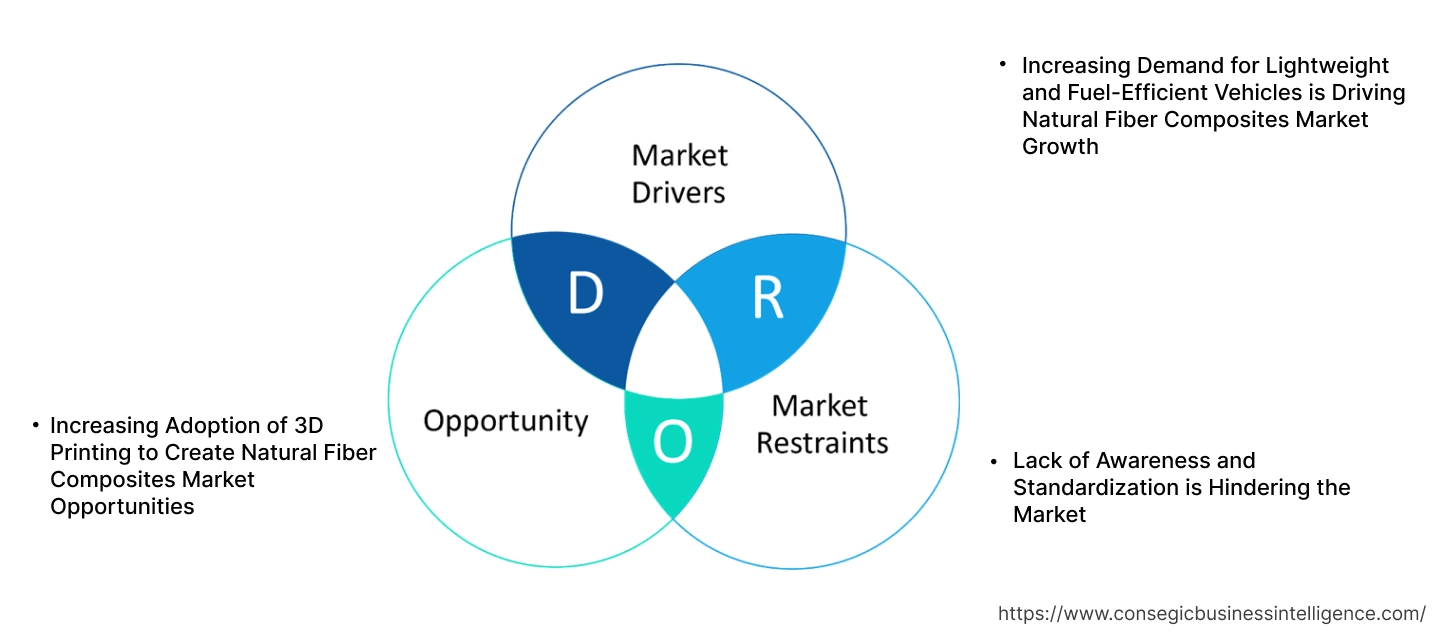
Key Restraints:
Lack of Awareness and Standardization is Hindering the Market.
Natural fiber composites market adoption is significantly hindered by a lack of awareness and insufficient standardization as many engineers, and industries remain uninformed about NFCs' capabilities, mainly resulting in utilization of traditional materials due to familiarity of performance limitations. In addition to this, absence of universal testing methods and standardized material specifications for NFCs is leading to another hurdle to ensure consistent quality, comparing products across suppliers, and build confidence in their long-term reliability. These aforementioned factors are contributing to hindrances in the natural fiber composites market expansion.
Future Opportunities :
Increasing Adoption of 3D Printing to Create Natural Fiber Composites Market Opportunities.
The increase in adoption of 3D printing technology allows for the development of intricate geometries and customized parts that are difficult to develop with traditional techniques, while simultaneously minimizing material waste through its additive nature. Furthermore, 3D printing facilitates rapid prototyping and cost-effective small-batch production by eliminating the need for expensive tooling, thereby making NFCs more accessible and economically viable for a wider range of applications. This enhances the sustainability aspect of NFCs creating potential for the future.
- For instance, according to ND Automatronics, the market of 3D printing across the globe is expected to experience a growth rate of more than 18% by 2030.
Thus, as per analysis, increasing adoption of 3D printing is expected to create natural fiber composites market opportunities.
Natural Fiber Composites Market Segmental Analysis :
By Product Type:
Based on Product Type, the market is categorized into wood fiber composites, flax fiber composites, hemp fiber composites, jute fiber composites, and others.
Trends in Product Type:
- Wood fiber composites are most preferred due to their abundant availability, relatively low cost, and good mechanical properties.
- Hemp Fiber Composites are gaining traction in the automotive sector for lightweight components, replacing glass fibers in certain parts.
The wood fiber composites segment accounted for the largest natural fiber composites market share in 2024.
- Wood Fiber Composites are dominating due to their widespread availability, cost-effectiveness, and desirable mechanical properties including strength, stiffness, and dimensional stability, particularly in the form of wood-plastic composites (WPCs).
- These materials are utilized in the building and construction sector for applications such as decking, fencing, siding, along with their wide usage in the automotive sector for interior components.
- For instance, according to Deloitte, the construction sector experienced an increase in 10% in nominal value in 2024 when compared to the previous year.
- Thus, as per the market analysis, the wood fiber composites segment dominates the natural fiber composites market expansion.
The hemp fiber composites segment is expected to grow at the fastest CAGR over the forecast period.
- Hemp fiber composites are majorly driven by the increasing focus on global regulatory landscape and widespread legalization of industrial hemp cultivation.
- This development is further increasing due to hemp's mechanical properties, which are mainly higher than those of glass fibers, making it an attractive sustainable alternative for demanding applications.
- Moreover, its environmental profile, requiring minimal water and pesticides and its versatile applications across automotive, construction, and bioplastics, hemp is becoming a material of choice for innovation.
- Thus, based on the market analysis, the hemp fiber composites natural fiber composites segment is growing at the fastest CAGR, driving the natural fiber composites market demand.
By End Use:
Based on the End Use, the market is categorized into automotive, construction & building, consumer goods, sporting goods, and others.
Trends in the End Use
- The natural fiber composites market trends are influenced by the growing focus of automakers to reduce vehicle weight and lower carbon emissions.
The automotive accounted for the largest natural fiber composites market share of 54.28% in 2024 and is expected to grow at the fastest CAGR over the forecast period.
- The automotive sector is prominent due to the growing focus of manufacturers to reduce vehicle weight for enhanced fuel efficiency in internal combustion engines and extended range in electric vehicles, alongside the imperative to lower carbon emissions.
- Consequently, NFCs are used into interior components such as door panels, seat backs, dashboards, headliners, and trunk liners.
- For instance, according to IBEF, The automotive component sector experienced robust growth in Fiscal Year 2024, with its turnover reaching USD 74.1 billion, representing a significant 9.8% increase compared to the previous fiscal year.
- Thus, based on market analysis, the automotive segment influences the market share and is expected to grow at the fastest CAGR over the forecast period.
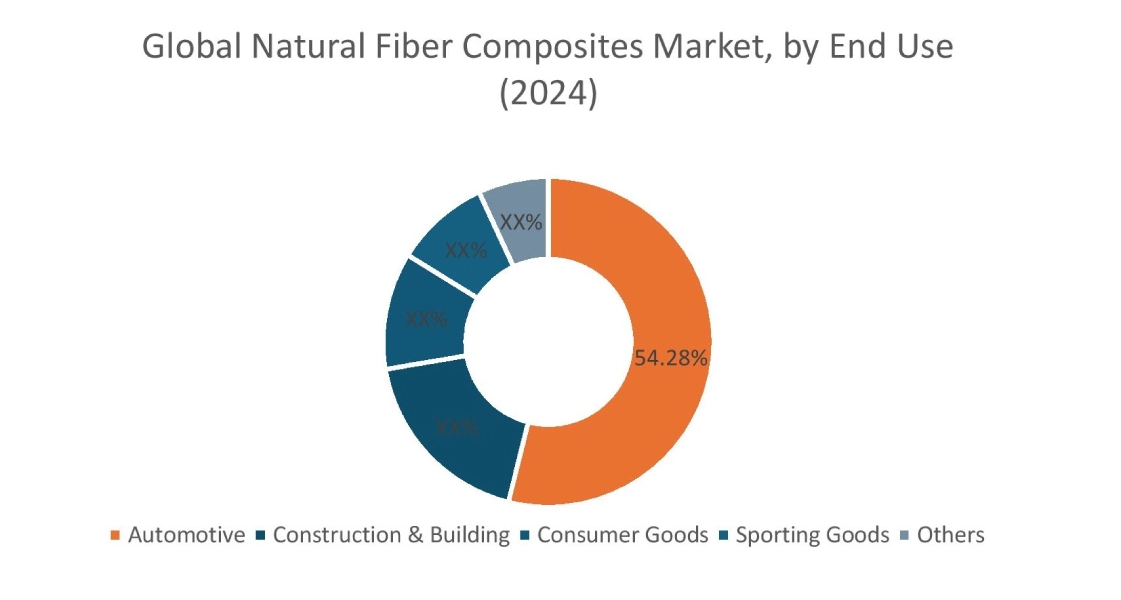
Regional Analysis:
The regional segment includes North America, Europe, Asia Pacific, the Middle East and Africa, and Latin America.
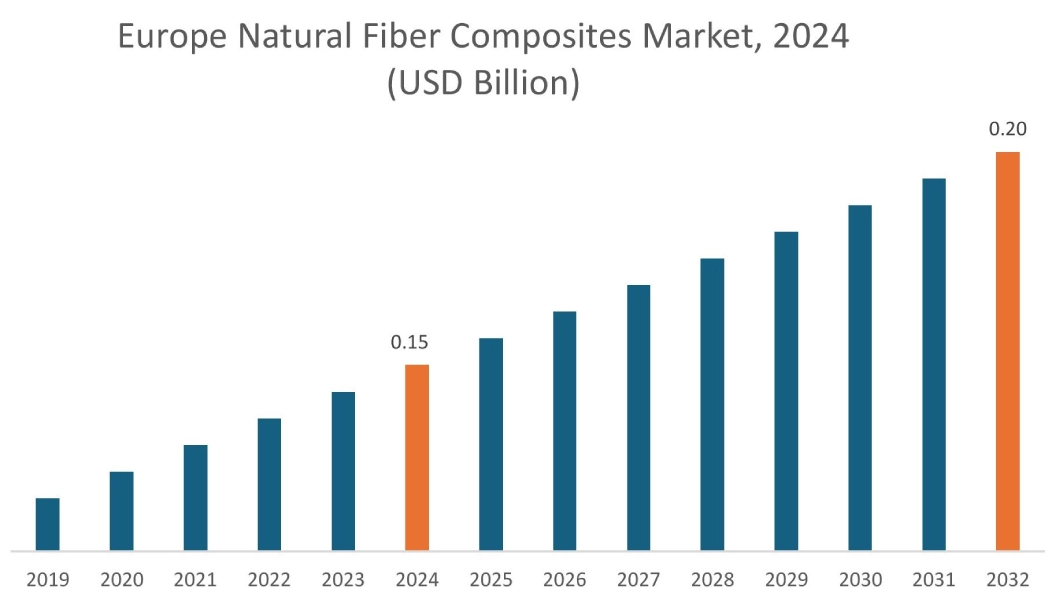
In 2024, Europe accounted for the highest market share at 39.45% and was valued at USD 0.15 Billion and is expected to reach USD 0.20 Billion in 2032. In Europe, Germany accounted for a market share of 22.38% during the base year of 2024. The growing trend for lightweight and fuel-efficient vehicles, driven by stringent emission regulations and consumer preference for sustainability, is significantly boosting the adoption of natural fiber composites in the European automotive industry. The rise in the adoption of light electric vehicles in this region is influencing the use of these composite materials.
For instance,
- The data by IEA, states that in 2023, the European market for electric light commercial vehicles (LCVs) experienced significant growth, surging by 60% to reach a volume of nearly 150,000 units.
Thus, as per the natural fiber composites market analysis, these factors create a strong upward trajectory for the European market, positioning it as a key region for players.
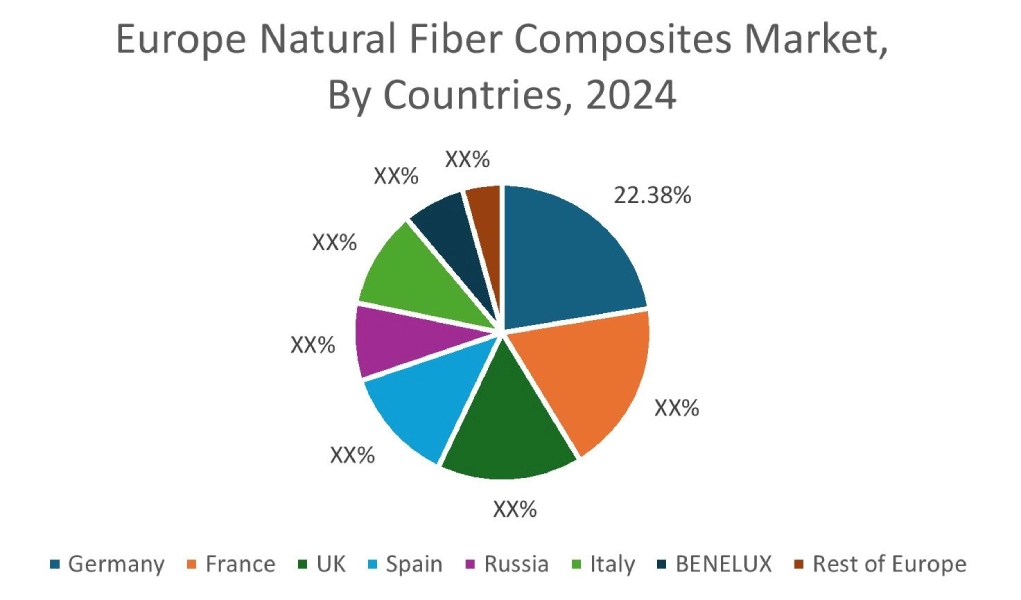
In Asia Pacific, the natural fiber composites industry is experiencing the fastest growth with a CAGR of 6.8% over the forecast period. The Asia Pacific region is experiencing a significant surge in the adoption of 3D printing, driven by rapid advancements in manufacturing technologies, supportive government initiatives promoting industrial digitization, and the increasing requirement for customized and on-demand production solutions across various sectors. Various industries are leveraging 3D printing to create lightweight components, personalized products, and prototypes more efficiently and cost-effectively, while also reducing material waste. Thus, as per the natural fiber composites market analysis, the rise in 3D printing activities is driving the trends of the market in this region.
The North American region is experiencing a significant surge in the requirement for bio-based and recyclable materials, largely driven by growing environmental awareness among consumers, stringent government regulations promoting sustainability, and manufacturer’s requirement for eco-friendly and cost-effective solutions. NFCs, made from renewable resources like wood, flax, hemp, and kenaf, offer a compelling sustainable alternative to traditional synthetic composites in various industries. Their lightweight nature, high strength-to-weight ratio, and biodegradability are proving highly attractive for applications in automotive interiors, building and construction, and even sporting goods, highlighting a broad shift towards more environmentally responsible material choices. Thus, as per the market analysis, the requirement for bio-based and recyclable materials is propelling the growth of the market in this region.
The Middle East and Africa natural fiber composites market is driven by the region's increasing industrialization, and government investments in infrastructure. Key areas for this expansion include the rapidly growing automotive and aerospace sectors, particularly driven by electric vehicle manufacturing and potential for aircraft interiors. The building and construction sector is also set to broaden its adoption beyond traditional wood-plastic composites to utilize NFCs for green building initiatives, prefabricated housing, and aesthetic interior design. These factors together are contributing to the natural fiber composites market demand in this region.
The development of hybrid composites presents a significant opportunity for Latin America's natural fiber composites, allowing the region to utilize its rich biodiversity and due to the abundant natural fiber resources available such as sisal, jute, coir, and increasingly, industrial hemp. By combining these natural fibers with synthetic fibers, hybrid composites are able to overcome inherent limitations of pure NFCs while retaining their sustainability advantages. These factors together are contributing to the natural fiber composites market trends in this region.
Top Key Players and Market Share Insights:
The Global Natural Fiber Composites Market is highly competitive with major players providing products to the national and international markets. Key players are adopting several strategies in research and development (R&D) and product innovation to hold a strong position in the global Natural Fiber Composites market. Key players in the Natural Fiber Composites industry include
- Flexform SpA (Italy)
- Procotex (Belgium)
- Polyvlies Franz Beyer GmbH (Germany)
- Green Dot Bioplastics (U.S.)
- Cortec Corporation (U.S.)
- TECNARO GMBH (Germany)
- UPM (Finland)
- Trex Company, Inc. (U.S.)
- Bcomp (Switzerland)
Natural Fiber Composites Market Report Insights :
| Report Attributes | Report Details |
| Study Timeline | 2019-2032 |
| Market Size in 2032 | USD 0.56 Billion |
| CAGR (2025-2032) | 5.2% |
| By Product Type |
|
| By End Use |
|
| By Region |
|
| Key Players |
|
| North America | U.S. Canada Mexico |
| Europe | U.K. Germany France Spain Italy Russia Benelux Rest of Europe |
| APAC | China South Korea Japan India Australia ASEAN Rest of Asia-Pacific |
| Middle East and Africa | GCC Turkey South Africa Rest of MEA |
| LATAM | Brazil Argentina Chile Rest of LATAM |
| Report Coverage |
|
Key Questions Answered in the Report
How big is the Natural Fiber Composites market? +
In 2024, the Natural Fiber Composites market is USD 0.37 Billion.
Which is the fastest-growing region in the Natural Fiber Composites market? +
Asia Pacific is the fastest-growing region in the Natural Fiber Composites market.
What specific segmentation details are covered in the Natural Fiber Composites market? +
By Product Type and End Use segmentation details are covered in the Natural Fiber Composites market.
Who are the major players in the Natural Fiber Composites market? +
Flexform SpA (Italy), Procotex (Belgium), TECNARO GMBH (Germany), UPM (Finland), Trex Company, Inc. (U.S.) are some of the major players in the market.
